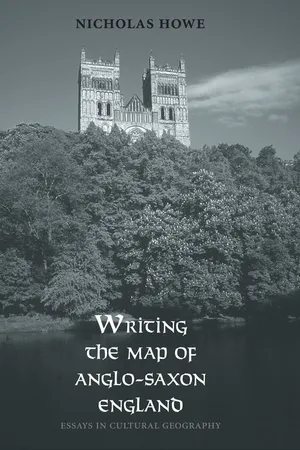
- English
- PDF
- Available on iOS & Android
About this book
Eminent Anglo-Saxonist Nicholas Howe explores how the English, in the centuries before the Norman Conquest, located themselves both literally and imaginatively in the world. His elegantly written study focuses on Anglo-Saxon representations of place as revealed in a wide variety of texts in Latin and Old English, as well as in diagrams of holy sites and a single map of the known world found in British Library, Cotton Tiberius B v. The scholar’s investigations are supplemented and aided by insights gleaned from his many trips to physical sites.
The Anglo-Saxons possessed a remarkable body of geographical knowledge in written rather than cartographic form, Howe demonstrates. To understand fully their cultural geography, he considers Anglo-Saxon writings about the places they actually inhabited and those they imagined. He finds in Anglo-Saxon geographic images a persistent sense of being far from the center of the world, and he discusses how these migratory peoples narrowed that distance and developed ways to define themselves.
The late Nicholas Howe was professor of English, University of California at Berkeley, and the author of several books, including Migration and Mythmaking in Anglo-Saxon England, published by Yale University Press.
Frequently asked questions
- Essential is ideal for learners and professionals who enjoy exploring a wide range of subjects. Access the Essential Library with 800,000+ trusted titles and best-sellers across business, personal growth, and the humanities. Includes unlimited reading time and Standard Read Aloud voice.
- Complete: Perfect for advanced learners and researchers needing full, unrestricted access. Unlock 1.4M+ books across hundreds of subjects, including academic and specialized titles. The Complete Plan also includes advanced features like Premium Read Aloud and Research Assistant.
Please note we cannot support devices running on iOS 13 and Android 7 or earlier. Learn more about using the app.
Information
Table of contents
- Contents
- Preface
- Acknowledgments
- Introduction: Book and Land
- Part I. Local Places
- 1. Writing the Boundaries
- 2. Home and Landscape
- Part II. Geography and History
- 3. Englalond and the Postcolonial Void
- 4. Rome as Capital of Anglo-Saxon England
- 5. From Bede’s World to ‘‘Bede’s World’’
- Part III. Books of Elsewhere
- 6. Books of Elsewhere: Cotton Tiberius B v and Cotton Vitellius A xv
- 7. Falling into Place: Dislocation in Junius 11
- Conclusion: By Way of Durham
- Notes
- Index